Obvious and impracticable? Adolp Führer's tank gun
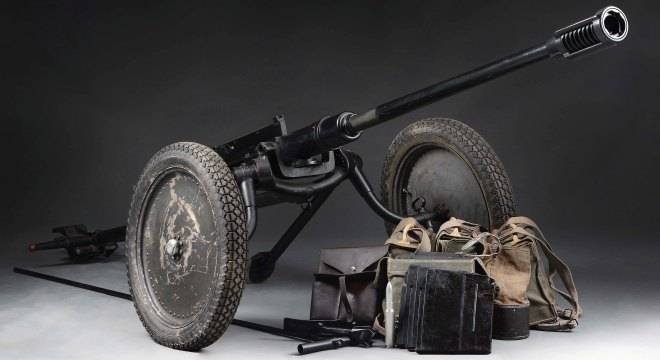
TB 41
People and weapon. Probably the dream of any designer is to create such a model of a locking device so that it would be universal. Let's just say it would be suitable for several weapon systems at once. After all, why is the Kalashnikov rifle so fond of us in Russia? Yes, because, in addition to all its positive qualities, a light machine gun, as well as an easel machine gun, was developed on its basis. They are all twin brothers, and this facilitates the training of soldiers and the use of weapons in a combat situation.
And in Switzerland at one time there was a man who came up with the original idea: to create a weapon system, from a pistol to an anti-aircraft machine gun, which would have the same barrel locking system. So that the same gun from the anti-aircraft gun would differ only in size.
The idea itself is simple. He bolted the shutter in the form of a metal bar weighing 200 g with a spring, put the magazine down - here’s your gun. He put the “bar” heavier, and the barrel is more authentic - a submachine gun, even harder - an automatic rifle. And if you have a 4-5 kg blank behind your barrel, here's the gun. Everything is simple, obvious and ... impossible, because weapons with a free bolt are suitable only for low-powered pistol ammunition.
The creator of the most precious stories submachine gun MP41 / 44 Adolf Führer. That's why he chose the reliable lever bolt from the Luger pistol, tested by time and operation, for his sample. And he made on it not only a submachine gun, but also a light machine gun under a rifle cartridge. Moreover, the military had no complaints about a light machine gun, so he served until the beginning of the 70s. But even the “dear” MP41 / 44 was scolded, but he was in the service for a very long time. So, he completely paid for himself!
And here, the initiative of Mr. Fürrer was visited by the bright idea of adding to his arsenal also a powerful anti-tank rifle with the same lever bolt. As the director of an arms factory in Bern, he had the opportunity to carry out any design work, test any ammunition, and have at hand absolutely everything that only his soul liked. Lucky, you can say, a person. Indeed, before the eyes of the Swiss there was a whole arsenal of the most modern weapons, purchased in various countries of the world!
As it must have been evident, Führer was a prudent and far-sighted man. He knew that the Swiss army needed weapons for promising armored vehicles and new ones purchased in Czechoslovakia tanks. This is how the first model of the Führer PTR appeared in 1938, and it was nothing more than a light cannon for a tank, and only subsequently it was improved and adopted in 1941 under the designation Tb 41 W + F, where the last letters indicate the name of the manufacturer, that is, a military plant in the city of Bern. It is not surprising that the “gun” turned out to be heavy, but nevertheless it was used in Switzerland throughout the Second World War and was discontinued only in the 1950s. Moreover, although they stopped producing it, it remained in service with some special forces until the beginning of the 70s. Rare longevity, given, for example, the fate of our Soviet mass anti-tank missiles during the war.
In total, by the end of the war, the Berne factory manufactured 3581 PTR TB 41. They began to be transferred to the infantry from May 1941. They also armed themselves with armored cars and ... patrol boats (!) Of the Swiss army. And by the way, it was on these boats that they lasted the longest! That is, it was originally supposed that it would be a tank gun, but when the matter did not go, the gun was simply called Tankbüchse 41 / Tb.41, that is, a tank gun.
That is, it all started with the fact that the Swiss military wanted to equip their new light tank with effective weapons: a fast-firing cannon, capable of bombarding enemy armored vehicles with a hail of shells, and two machine guns. And then Colonel Adolf Führer and offered them his development. It was a long-barrel 24-mm cannon Pzw-Kan 38, which served as the main weapon for the armored car 39 LT-H (Praga) and Pzaw BK 38. But why was such a strange caliber chosen for it? But why strange? After all, a 25-mm anti-tank gun was adopted in France, and in the USSR a 25-mm anti-aircraft gun.
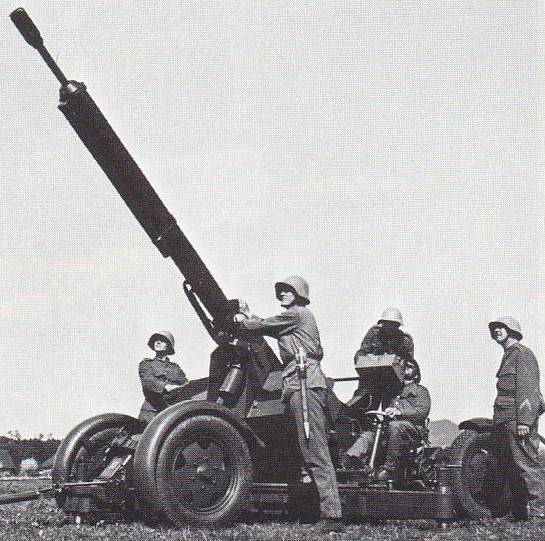
Water-cooled automatic 34-mm anti-aircraft gun manufactured by Oerlikon, adopted in 1938 and was in service with the Swiss Confederation until 1960, when it was replaced with a 35-mm gun!
By the way, Führer also designed the anti-aircraft gun using the same principle of automation, and the caliber for her was also chosen not quite ordinary - 34 mm, although the caliber commonly used in Europe was 37 mm. A high-explosive shell weighing 720 g left the barrel of this gun at a speed of more than 900 m / s. The 34-mm cannon was an enlarged copy of the 24-mm system, but with a tape, rather than magazine feed, ammunition rate of 350 rds / min. However, the light tank Panzerwagen 39, an analogue of the Czech LT-38, for the armament of which this gun was originally intended, did not go into the series. And then they decided to convert the tank gun into an infantry anti-tank gun.
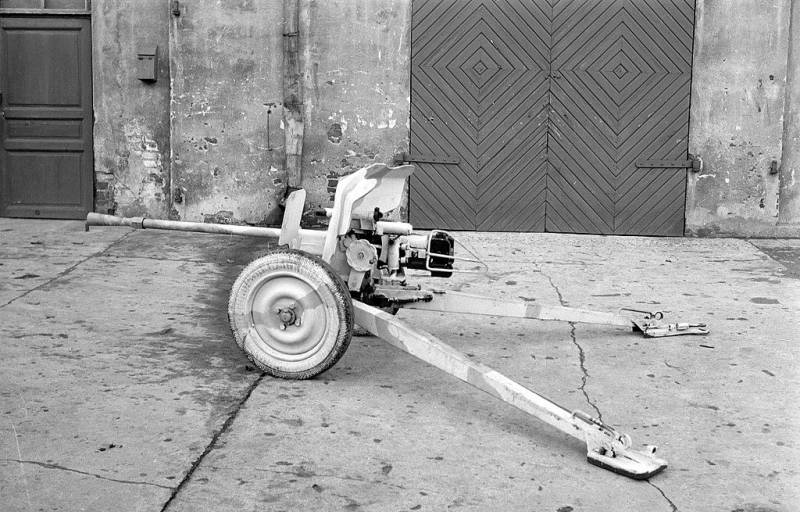
Hotchkiss Canon léger de 25 antichar SA-l modèle 25 French 1934 mm anti-tank gun in the Finnish service. Finnish gun designation was 25 PstK / 34
Tb 41 received the same bolt from the Luger pistol, but laid on its right side, so that the levers folding after firing extended to the right. I had to cover them with a protective casing of a sufficiently large size, because of which its breech began to look unusually flattened. She held on and aimed at the target with the help of two handles, and the shot was fired by pressing the trigger, as if with a Maxim machine gun. The gun was also supposed to be used in an anti-tank fortification gun. Since the velocity of the projectile of this gun was very high, to reduce recoil at the end of its long barrel, a large muzzle brake had to be installed. It consisted of five split and three blind rings, and the rings in the muzzle brake could be changed (!), Changing the size of the holes between them, and thus regulating the recoil force - the solution is very unusual and truly original. This made it possible to shoot from this gun both from a wheeled carriage, and a machine-gun carriage, and from a special installation mounted inside the bunkers.
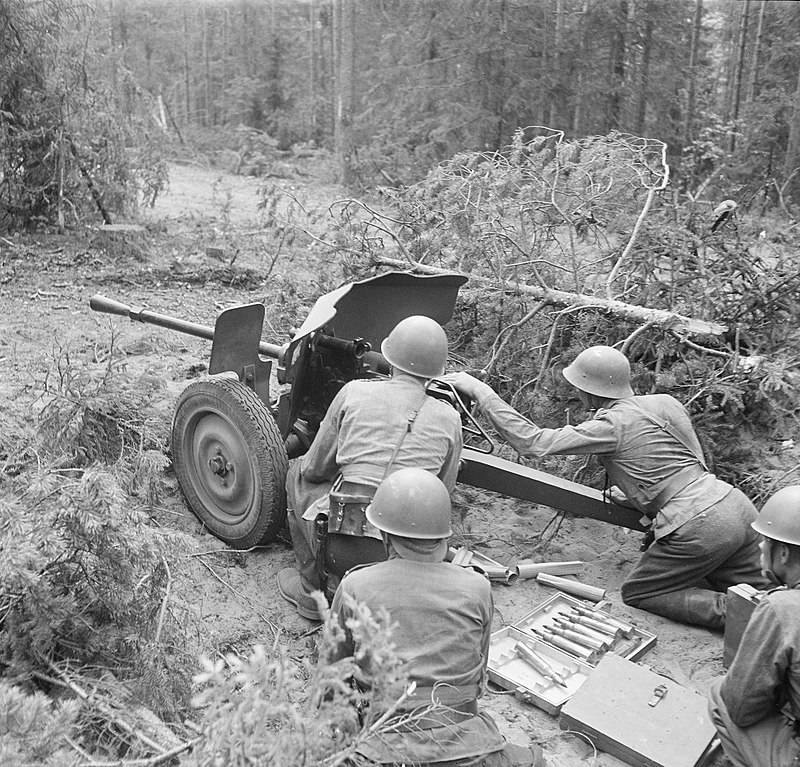
Finnish 25 PstK / 34 in battle. June 25, 1941.
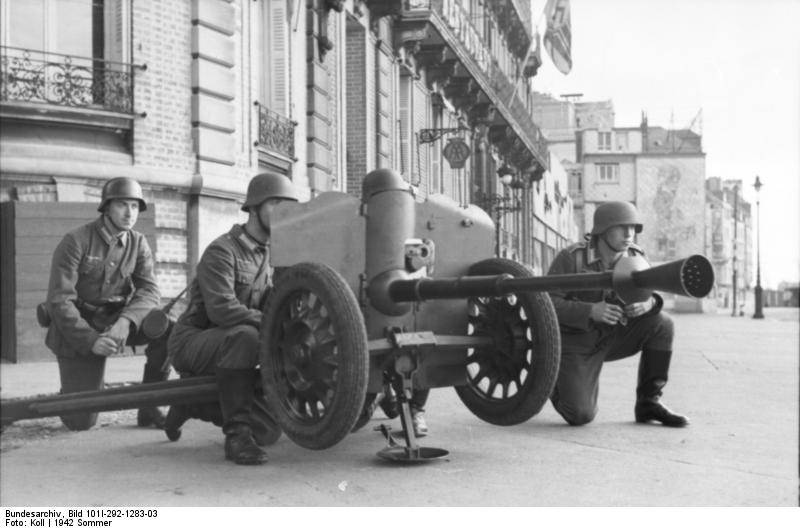
Wehrmacht soldiers at the gun 2,5-cm-PaK 113 (f) (French 25 mm gun Modèle 1937)
As already mentioned, the principle of locking the barrel of this gun was used the same as that of the Swiss light machine gun Lmg 25. In the locked position, all the moving parts of the bolt, as well as the barrel itself, were on the same line. When fired, the barrel retreated due to recoil force along with the bolt and levers, one of which fell onto the protrusion in the receiver and changed its position relative to the other two levers, which folded and made a slide, pulling the relatively light shutter back (In this case, the spent cartridge case was extracted, and the bolt immediately pushed by the spring went forward again. He grabbed a new cartridge from the magazine and pushed it into the chamber. The levers were straightened, forming a straight line, and so it went For loading the rear, a special lever was installed on the body that pulled the movable part of the weapon, that is, the barrel, and the bolt back, as when firing, forcing the levers to first fold and then straighten.
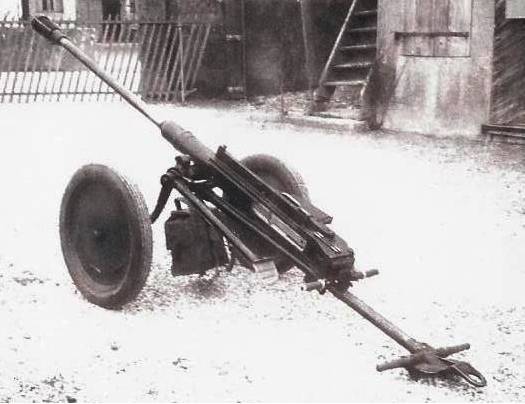
Führer’s tank gun mounted on wheels
Führer’s tank rifle could fire effectively at a distance of up to 1500 m. But the shells from it flew all 3000 m, so that it was possible to shoot at this distance, but an optical sight was needed, which, however, was rarely used. The supply of cartridges took place, like a machine gun, on the right side from a six-shot magazine, and the ejection of cartridges took place on the left. After the last shot, the store is automatically thrown away, which saves time on reloading.
When the “gun” was used as an infantry weapon, it could be transported on a wheeled carriage with pneumatic tires, and in this form it could also be fired. With the wheels removed, its undercarriage was a three-legged carriage with carrying handles. In addition to the wheeled carriage, it was possible to use the Mg 11 carriage. For this, a special support had to be installed under the gun.
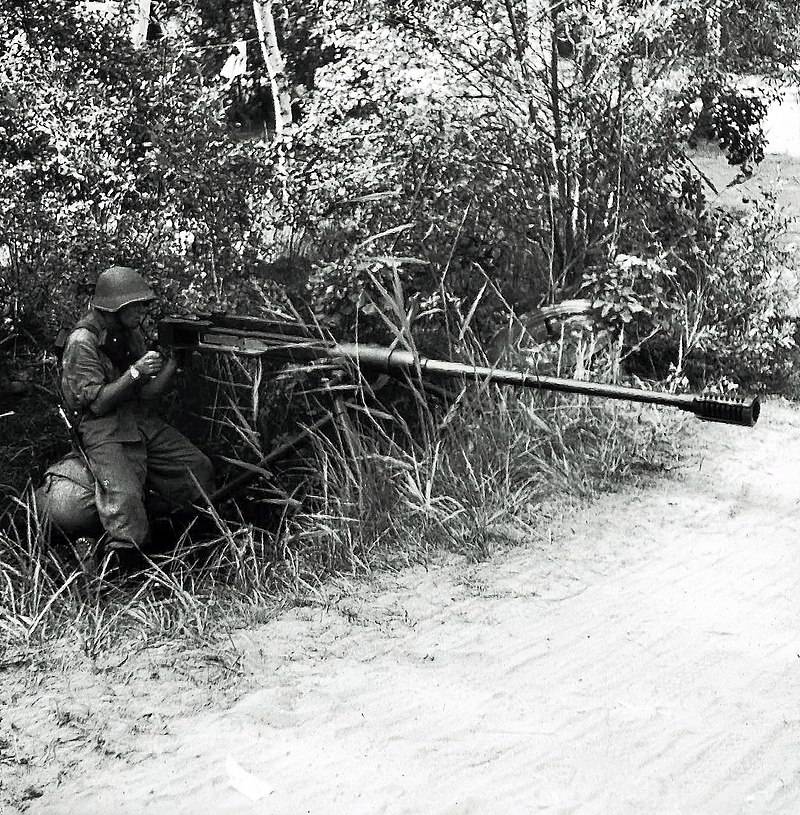
It is on a tripod installation (photo from the Museum of Archeology and History of Baselland)
Shells were used in hardened steel. At the same time, the armor-piercing shell did not have a bursting charge, but it had a tracer. The kit also included a St-G steel grenade with a TNT charge. The tanks could be fired with a UG half-armor-piercing grenade with a fuse delay, as well as a smaller explosive charge. All shells were equipped with copper lead belts.
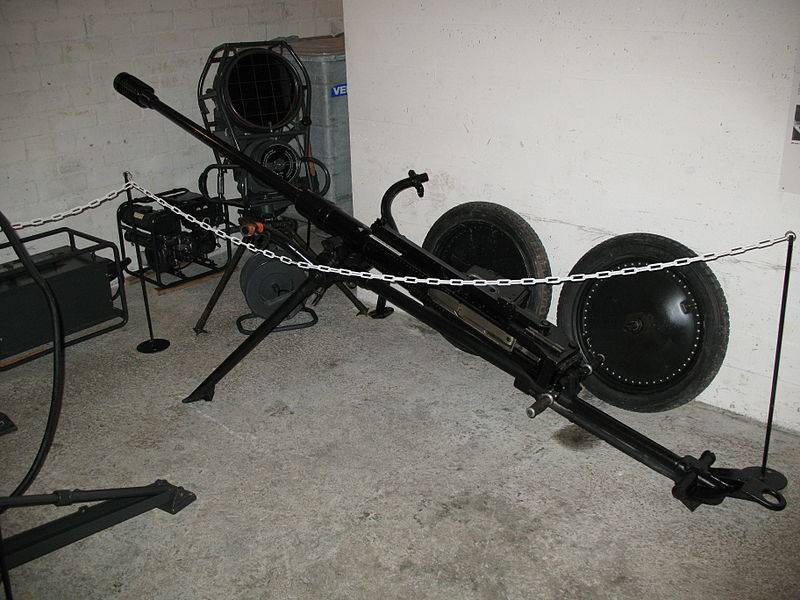
Tb 41 with wheels removed and without a protective cover of the shutter levers that are clearly visible (Walrus Castle Museum, Lausanne)
The barrel weighed 77 kg, and together with the machine gun, it already weighed 132 kg. The barrel length was 1515 mm.
The total weight of the ammunition 24x139 mm was 460 g. The projectile weighed 225 g. The tracer burned for 2,3 seconds. There are no data on the armor-piercing performance of this system, however, there can be no doubt that it had to penetrate 20-mm armor of the then German tanks at a considerable distance. Here is the data for the French 25 mm gun: armor penetration at a meeting angle of 30 ° 36 mm at a distance of 100 m, 32 mm at 300 m, 29 mm at 500 m and 22 mm at 1000 m. At a meeting angle of 60 ° 35 - 100 m, 29 - at 500 m, 20 - at 1000 m. It is unlikely that the Swiss 24-mm gun was weaker, especially when you consider the length of its barrel.
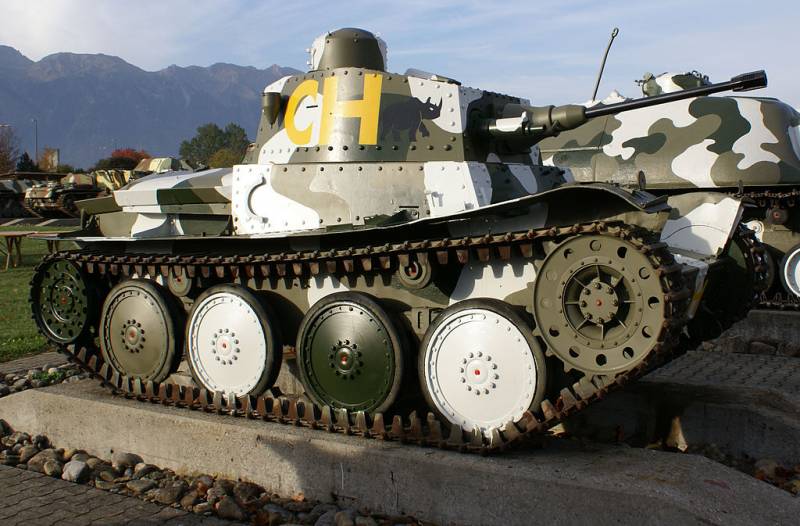
Information